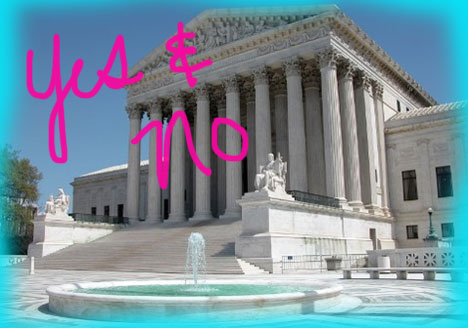
Two important criminal justice rulings came down from the Supremes today. (More details on both these cases late tonight, but for now, here are the broad strokes.)
LWOP KIDS
In a 5-4 ruling with Justice Kennedy writing for the majority, the Supreme Court ruled that a sentence of life without the possibility of parole—LWOP—for a juvenile in a crime where no homicide has been committed constitutes cruel and unusual punishment, according to the 8th Amendment of the Constitution. (Justice Roberts joined in a part of the decision, making some of it 6-3.)
This is a ruling with huge implications-–and a welcome victory for those of us who believe that kids should at least have the possibility of parole.
Here’s a report on the ruling from David G. Savage at the LA Times.
FYI: California has 249 LWOP kids but only 2 are locked up for crimes that did not involve murder.
CIVIL CONFINEMENT FOR SEXUAL PREDATORS
As Doug Berman of Sentencing, Law & Policy wryly pointed out––just to make clear that the Supreme Court is not in the least unaware of PR issues, on the same day that they leaned in a slightly liberal direction in their ruling on the LWOP issue, SCOTUS cannily scheduled another criminal justice-related hot potato case in which they came down firmly on the law-and-order, power-of-the-federal government side of things (“Not that there’s anything wrong with that.“:
In a 7-2 ruling on US v. Comstock, the court said that Congress has the authority under the Constitution to allow the continued confinement of certain kinds of convicted sex offenders after they have completed their sentences.
(Thomas and Scalia were the two dissenters.)
Here’s the relevant explanitory ‘graph from Adam Liptak’s article in the NY Times.
The law allows the federal government to continue to detain prisoners who had engaged in sexually violent conduct, suffered from mental illness and would have difficulty controlling themselves. If the government is able to prove all of this to a judge by “clear and convincing” evidence — a heightened standard, but short of “beyond a reasonable doubt” — it may hold such prisoners until they are no longer dangerous or until a state government assumes responsibility for them.
However, there is much, much more to this case having to do with what powers the federal government is or is not allowed under the Constitution.
Back on both cases very, very late tonight.

I agree with both decisions.
I’m sure the Court will sleep better knowing that.
They all called me Joe and told me that they would.